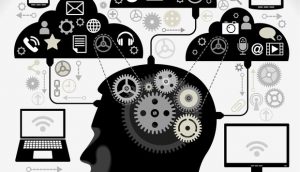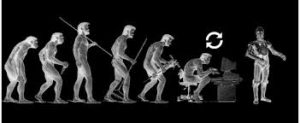Machine marketers are smarter marketers, always using machines for advantage. But this isn’t new.

Image source: http://blog.datumbox.com/datumbox-machine-learning-framework-0-6-1-released/
Direct marketing was born out of the ability to exploit addressable media as the way to garner feedback on whether their enticements were working. Catalogs and snail mail with reply forms, evolved to email, telemarketing, and other mechanisms – smarter marketers understood guesswork would never win over using data, technology, and the scientific method.
Database Marketing
In the 90’s, the ability to more massively codify and share customer data, and use it to steer marketing campaigns drove a revolution. It sparked a major shift of media spending away from general advertising using TV & Radio, to addressable programs. Database Marketers, the offspring of Catalog Marketers and ancestors of Machine Marketers, scraped for individualized customer information to power personalized treatments – where direct response open rates, response rates, and conversion rates kept score.
They loved data because when they used it to drive targeting in their programs, the patient responded. Realizing their treatments were working, they wanted more data, wanted it fast, and wanted it in pure forms. Native sources worked well, but they sought alternate supplies in the forms of public, compiled, and modeled data – anything to test for a slight edge.
A new market formed with a vast array of players, arising to meet the growing demand for customer data.
The 2nd Coming of Big Data
Then, a number of things happened. Even more individualized data poured onto the market. Consumers shopped and bought online. Consumers went mobile. Consumer devices of all kinds started streaming behavior data. Consumers readily traded personal information for points and promises.
Hardware continued to plummet in price and better software meant cleaner and more accessible data. Data compilers flourished, with data as their raw material, and database & data science technology their assembly line, and the internet their logistics network.
Database marketers had struck oil again, but this time it was BIG – and IoT data was the source of their new bubbling crude. Data refineries appeared everywhere.
Internal IT had competition – their 90’s data warehouses rendered obsolete by a Big Data revival. Open source databases like Hadoop, were faster and ran on commodity hardware. SaaS providers offered a variety of big data subscription services, and agencies used bigger and faster hosted databases.
There was but one small problem. Insights weren’t leaping out of these primordial big data reserves.
Data Science and Data Mining Come of Age
Meanwhile, mad “Data Scientist” marketers continued to manipulate and tune their statistical models to improve lift. Early on, they realized that algorithms devised hundreds of years prior could now be fine-tuned and fully unleashed to predict which customers were more likely to respond and buy their products.
Less sampling with faster machines and more data meant better results. Suddenly, more people became interested in what they were doing. People were peering over their shoulders. The press told stories of firms predicting a pregnancy before grandparents even knew. Adding fuel, the biggest brands on the planet (Google, Facebook, Amazon, et al) got into the game, doing big reveals, seemingly weekly, on the methods to their data science madness.
It was time to give this a makeover, market it, and commercialize it. “Geez,” said the creative marketer. “We can do that!”
AI and Machine Learning – The re-launch
Our story takes us to circa 2012. The time was right. Cars were beginning to drive themselves; IBM’s Watson had won Jeopardy; Google was predicting our search terms and winning at the game Go. Our iPhone was conversing with us, and Amazon & Netflix were courting us with recommended products to buy and movies to watch.
Honestly, no new science unexpectedly sprang forth, but as happens old science around for decades (decision trees, neural nets, Bayesian learning), became an overnight – well let’s call it an over 5 year – sensation.
What happened was how technology revolutions occur. Attention begot investment, huge investment bought more innovation, and marketable innovations caught more attention – and the virtuous loop was in motion – adequately fed by a rich venture capital environment.
Marketers assembled the pieces into cost effective working solutions. They collected and compiled consumer data sources, cleansed and filtered them, fed them into pattern recognition and self-learning systems, detected opportunities and alerted touchpoint systems, automated waved campaign schedules, and connected their outputs to fulfillment systems. They did all this via an interconnected stack of private and public clouds, transferring data and insights in seconds.
Michelangelo meets Newton – When Content met Context

Illustration: Christine Daniloff/MIT
By 2016, another phenomenon unfolded. Creative & scientific minds more closely collaborated.
Deep Learning, the science of neural networks, commoditized language and image processing, changing how we interfaced and worked with machines. Clunky interface paradigms gave way to elegant ones that were responsive and rewarding. Design thinkers (those artsy fartsy types) were no longer an afterthought. Au contraire, they were now a strategic advantage. Consumers dictated the definition of great customer experience: Relevance, value, simplicity, and visual beauty.
Machine Marketers, ever the opportunistic breed, seized the moment, further refining their targeting and personalizing creative treatments across available channels. Machines further assisted their agency suppliers, assisting them in turning out better, faster, and cheaper creative. Technology further assisted marketers, auto generating optimal SEO terms, email subject lines, and even catchy tweets. Machines advised on the optimal time to execute campaigns. Next best recommendation rankings used statistical probability to find relevant products & services for more refined targets.
Beautiful creative no longer took months to produce. In many cases, consumers produced content for brands – and the content bottlenecks holding back visual personalization broke lose.
Science and technology glued yet another critical piece into place. Touchpoint systems where customers interacted could now understand natural language, and instantly fed back contextual data (location, last behavior, weather conditions, intent, mood, and so forth) straight through to systems primed with algorithms that learned in real-time, recalculating next best actions in a conversational mode.
“Computer, find me the closest coffee shop.”…”Ok, I found one 2.5 miles away, do you want directions?”
“Computer, I need a highly rated case for my X phone for under $25.”…”Ok, I found four with 5 star reviews that fit your X phone for under $25, do you want to hear about them?”
Fronted by Natural Language Processing (NLP), personalization engines married conditional & appealing content with contextual recommendations – spawning audio & visual personal assistants. The result: off the charts lift and conversions.
These were contextual, conversational, and relevant interactions. This was transformational.
Machine Marketers Rise Up

Image source: http://meditateinnorthants.com/artificial-intelligence/
In the end, let’s face it. Marketers want to do one thing more than anything – sell more stuff. Yet the smart ones know that the best means to that end is relentless focus on the customer. Ensure each is a happy camper via an individualized relationship, and satisfaction and profits increase.
Thus, today more than ever, ALL marketers had better face one important fact. They can’t achieve customer centricity at scale using the tools, data, or organization of yesterday.
Like any profession, winners constantly seek a new competitive edge using the latest technological advances in equipment, repeatedly testing innovations, measuring for improvement, and fine-tuning.
Artificial intelligent interfaces are changing the ways consumers interact with their devices, provide data, and interact with brands. Data is flowing freely, and although privacy laws seem to ebb and flow, the trend has been toward more data sharing and the ability for the crafty to gain a deeper understanding of consumer behavior.
Technology – cheaper, smarter, more portable, and easier to use, continues to translate into the potential to deliver more relevant and convenient customer experience. Those that get this, and execute on it, will win.
Machine marketers are those who master using the latest data & technology to their advantage – rising to that challenge, they rise to the top of their craft.



